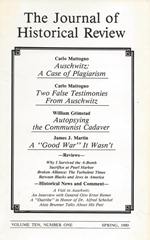Broken Alliance: The Turbulent Times between Blacks and Jews in America
Broken Alliance: The Turbulent Times between Blacks and Jews in America by Jonathan Kaufman. New York: Charles Scribner's Sons, 1988. 311 pages, $19.95, Hb., ISBN 0-684-18699-3. Broken Alliance is an account of how the twentieth-century alliance between Jews and blacks in the United States came into being, and how it came to be broken. Concentrating…

